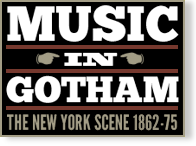Thomas Central Park Garden Concert
Event Information
Venue(s):
Central Park Garden
Proprietor / Lessee:
John Koch
Conductor(s):
Theodore Thomas [see also Thomas Orchestra]
Price: $.50; $1 & $2 extra, private boxes
Event Type:
Orchestral
Record Information
Status:
Published
Last Updated:
30 June 2025
Performance Date(s) and Time(s)
10 Jun 1875, 8:00 PMPerformers and/or Works Performed
Citations
Includes a descriptive analysis of Liszt’s Hungarian Rhapsody, no. 5.
“The ‘classical’ concert at the Central Park Garden last Thursday drew a crowded house, and called out unusually frequent and enthusiastic applause. The following was the programme [see above].
The two dance measures from Bach’s 1st orchestral Suite were tried for the first time last Tuesday. Then they made a pleasant impression, but their repetition on Thursday, when the performance had gained greatly in spirit, clearness, and that perfect precision which Bach’s music requires for its due effect, may be said to have made a sensation. The forlane is a Venetian dance of a stately and deliberate character; the bourrée, or boree, is a sort of measure better known, consisting of a lively and strongly accented movement in common time; it is said to have come from Biscay, and to derive its name from blustering Boreas. If it was originally wild and stormy, good society has doubtless mollified its manners, for it seems vastly genteel nowadays by comparison with other national dances, for instance those of Hungary. Bach always made the bourree one of the most fascinating of airs, and there are perhaps few gayer and more refined specimens of it to be found in his writings than this which Thomas has just brought to our knowledge. It is in three parts; the first is in the familiar form; the second is a charming trio, for hautboys and bassoon; the third is a repetition of the first. The Suite is scored for strings, hautboys, bassoons, and two horns; flutes (and of course clarinets) are not employed.
The Hungarian Rhapsody which appears on this programme was also played for the first time on Tuesday. It is one of the six we recently mentioned as having been attained by Thomas this season, the orchestration being the joint work of Liszt himself and A. F. Doppler of Vienna, the celebrated flutist. It is a transcription of the fifth of the piano-forte rhapsodies, entirely different in spirit, in style, and in instrumental coloring from the others of the series which we have heard. It is a pathetic poem whose burden is borne by the strings, and much of it is virtually a solo for the ‘celli—a poem of a prevailing somber cast, but with an undertone of passion which rises in the course of the piece to a fine climax. Much more than the other rhapsodies it needs the watchfulness of a sympathetic conductor to manage these varying nuances of expression upon which Liszt lays so much stress as essential to the proper interpretation of his music, and thus we need hardly say it had in Theodore Thomas, so that the performance was most eloquent and beautiful. Beethoven’s noble overture, the fine selection from Schubert’s ‘Rosamunde,’ and the fiery arrangement by Berlioz of the Rakoczy March were all thoroughly enjoyed; and then for the second part of the concert we had a superb interpretation of Schumann’s delicious B flat Symphony.”

